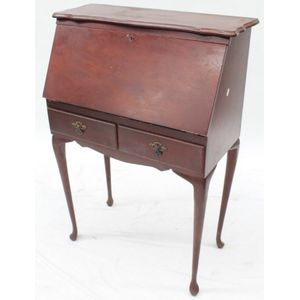Inlaid Piano Dressing Table Box with Fitted Tray
Piano form musical dressing table box with ivory and satinwood inlay, mirrored interior with a fitted tray containing a part sewing set (some damage) dimensions 29 x 20 x 16.5 cm
You must be a subscriber, and be logged in to view price and dealer details.
Subscribe Now to view actual auction price for this item
When you subscribe, you have the option of setting the currency in which to display prices to $Au, $US, $NZ or Stg.
This item has been sold, and the description, image and price are for reference purposes only.
- Ivory - Ivory is a hard white material that comes from the tusks of elephants, mammoth, walrus and boar, or from the teeth of hippopotamus and whales. The ivory from the African elephant is the most prized source of ivory. Although the mammoth is extinct, tusks are still being unearthed in Russia and offered for sale.
Ivory has been used since the earliest times as a material for sculpture of small items, both in Europe and the east, principally China and Japan.
In Asia ivory has been carved for netsuke, seals, okimono, card cases, fan supports, animals and other figures and even as carved tusks.
In the last 200 years in Europe ivory has been used to carve figures, for elaborate tankards, snuff boxes, cane handles, embroidery and sewing accessories, in jewellery and as inlay on furniture. Its more practical uses include being used for billiard balls, buttons, and a veneers on the top of piano keys.
The use and trade of elephant ivory have become controversial because they have contributed to Due to the decline in elephant populations because of the trade in ivory, the Asian elephant was placed on Appendix One of the Convention on International Trade in Endangered Species (CITES), in 1975, and in January 1990, the African elephant was similarly listed. Under Appendix One, international trade in Asian or African elephant ivory between member countries is forbidden. Unlike trade in elephant tusks, trade in mammoth tusks is legal.
Since the invention of plastics, there have been many attempts to create an artificial ivory - Satinwood - Satinwood is a dense pale gold coloured timber that was imported into Britain in the second half of the 18th century, and early 19th centuries from the East Indies and the West Indies. The name derives from the satin-like surface sheen when the timber is polished.
It was used in the solid, as a veneer and in inlays. As well as furniture, satinwood was used for making musical instruments, barometers, boxes and clocks.
It will usually be found on only the very best quality objects, presumably because of of its cost at the time.
This item has been included into following indexes:
Visually similar items

A French Louis XVI style walnut bedside cabinet, with inset marble top, above frieze drawers with ormolu decoration, below panel drawers on turned tapering legs. 84 cm high, 39 cm wide, 38 cm deep
Sold by
in
for
You can display prices in $Au, $US, $NZ or Stg.

A Queen Anne style writing bureau, 110 x 76 x 39 cm
Sold by
in
for
You can display prices in $Au, $US, $NZ or Stg.

An Art Deco Macassar ebony chest, Continental, circa 1930
Sold by
in
for
You can display prices in $Au, $US, $NZ or Stg.

A French rosewood single drawer dropside table. 71 cm high, 56 cm long, 37 cm depth
Sold by
in
for
You can display prices in $Au, $US, $NZ or Stg.
